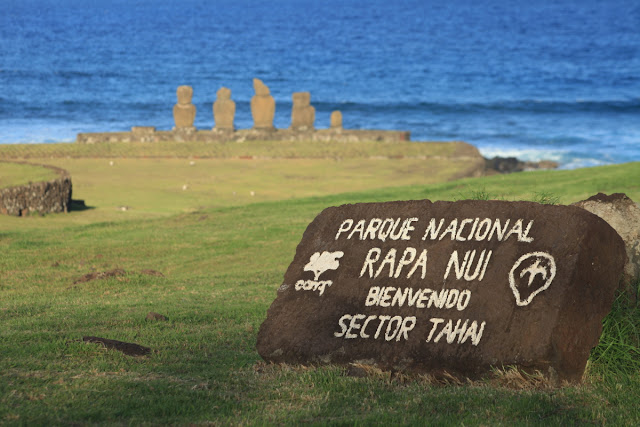Here are some photographs and captions from our full day on Easter Island
We began our morning very close to the hotel on the west coast of the island. This was the first ahu (altar) to be restored in 1968. It is called Tahai.
Looking back to the south to ur hotel
This is the foundation of a boat house, a place where nolility of the island lived. People likely arrived here between 800 and 1000 AD. Before that time, it was an uninhabited island with a forest of endemic trees. People soon began to grow their civilization from a seed group of about 50 people, arriving on double hulled canoes from the Marquesas to the east. In a few hundred years, the population was around 15,000 people.
The statues at Tahai upon an ahu (altar or platform)
In the background is one of the few statues with the eyes recreated. The white is made from coral rock and the black is made from either basalt or obsidian.
A local islander proudly poses for a picture. Today about 6,000 people live on the island and of these about 2,700 are considered Easter Islanders or natives.
We drove east along the south shore got a great view of the Poike shield volcano. It is the oldest on the island and these lavas erupted about 780,000 years ago - coincidentally just about the same time that lava in the Grand Canyon began to erupt near Toroweap Valley.
We were on our way to Ranu Raraku tuff cone, the site of the statue quarry for the whole island. This volcano erupted in the presence of water and thus allowed the ejected tephra (cinders) to become porous enough for working with stone tools.
Here is a close-up of the deposit in the tuff cone. Camera cap for scale. Note the larger blocks that were erupted along with the pea-size cinders. Must have been a grand eruption!
Here is a view of the main quarry site. 397 statues were found in this area. Only 800 statues are located on the entire island. It appears that statue creation was in full swing when they rather quickly stopped making statues. In the photo above you can see numerous statues in the process of carving. Note how workers would start on the top forming the face and then chisel their way down along the sides of the torso. Then they would begin to carve beneath a statue, some that eventually would weigh 80 tons or 160,000 lbs.! With a "keel" of rock still attached to the earth, they would cut out holes in the keel, then place round logs in those holes. Then they would remove the final portions of the rock and let the statue down to the plain below.
Close-up of unfinished statues
Here are some various statue shots of the ones standing at the base of the quarry. Note the expression and detail!
Nose and mouth with lichens
Awesome!
Hanging out with the statues
If you turn around 180 degrees from the Quarry area, you can look southeast and see Ahu Tongariki. This is one of the most dramatic sites on the whole island and it tells a fantastic story.
In May, 1960, the largest earthquake ever recorded on planet earth struck the coast of Chile in South America. A giant tsunami raced across the Pacific unimpeded for 5 hours, traveling at about 500 miles per hour. The brunt of the wave came ashore at Tongariki and picked up all 15 fallen statues (some 70 tons in weight) and transported them a mile inland. Unbelievable! In 1992, a Japanese construction firm sent a giant crane to the island and the statues were repositioned on the ahu.
Even though many of the statues were transported by the tsunami far away from the ahu, the archaeologist who oversaw the project knew where each statue needed to be repositioned. This is because in 1914, Kathrine Routledge numbered the fallen statues and took photographs of them.
The results are stunning!
Next we visited Anakena Beach, thought to be the location of where the first Easter Islanders landed ashore.
Here we enjoyed a bar-b-q
And a stunning South Pacific view
These photo's are for y wife, who loves the beach and how I wish she could be here with me to see this place.























No comments:
Post a Comment
If your comment will not post, email me with the problem.